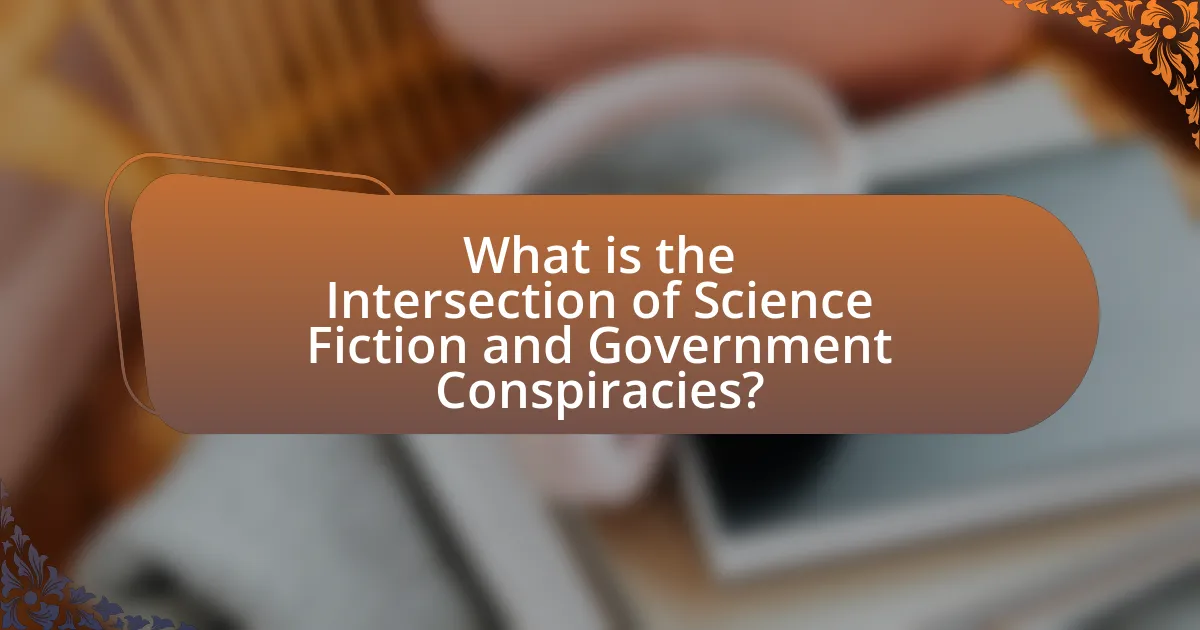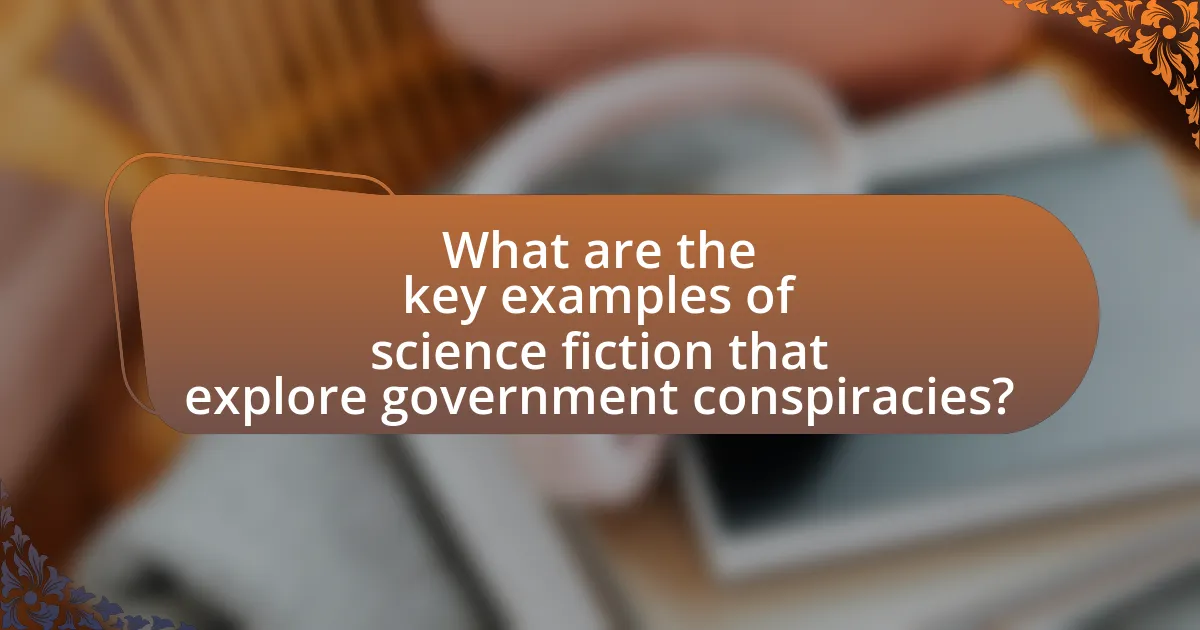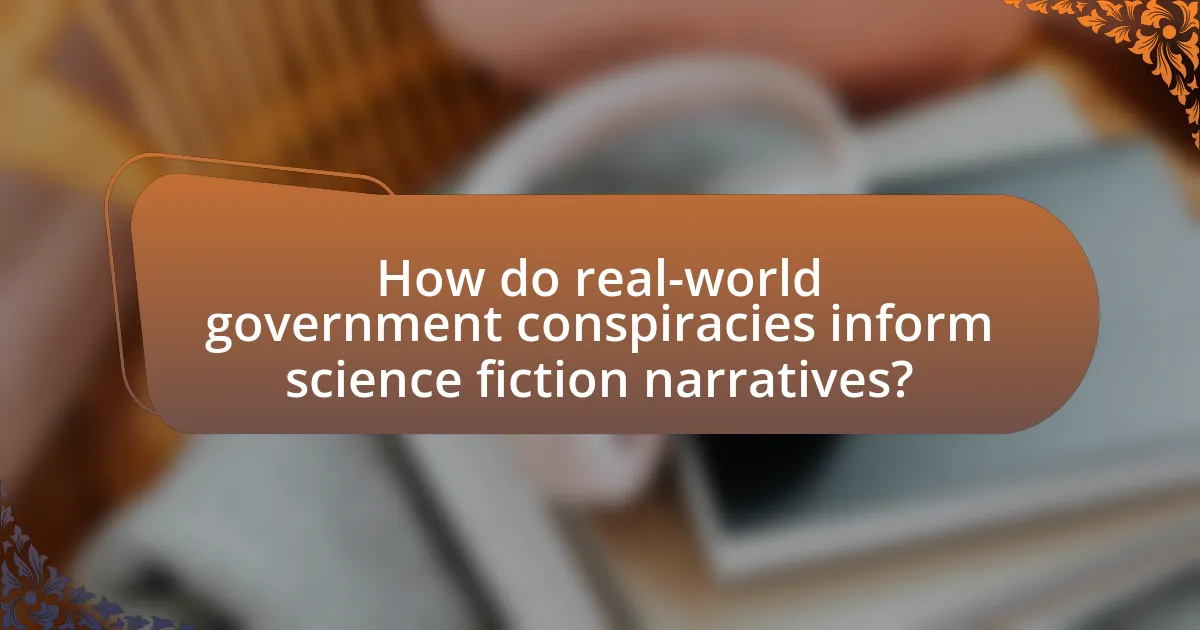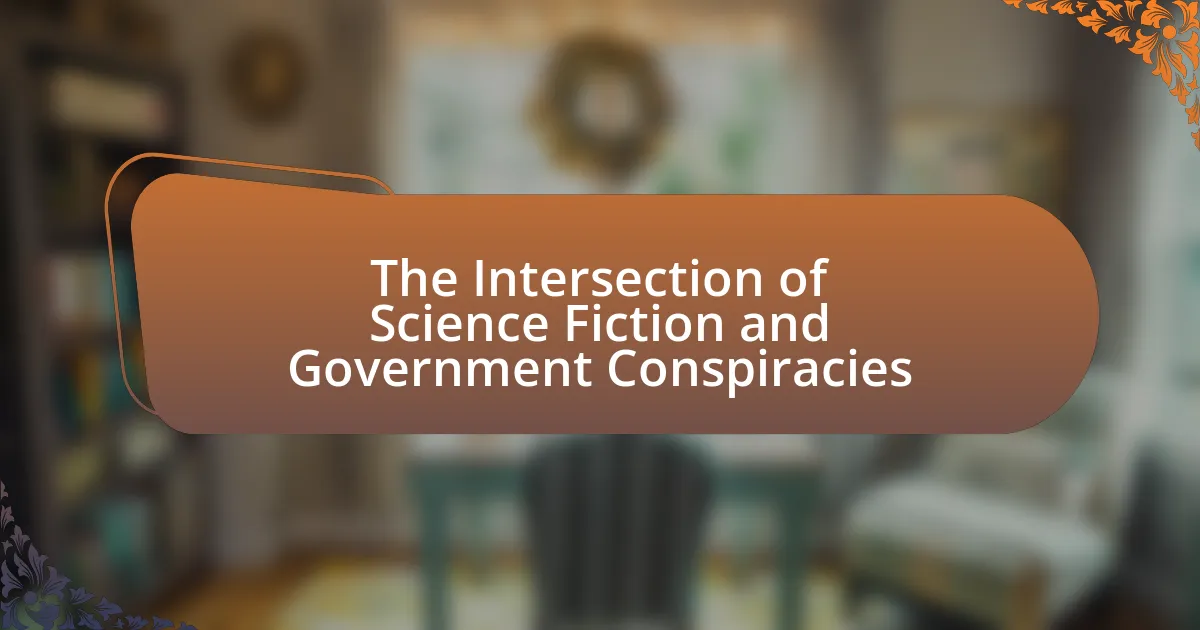The article examines the intersection of science fiction and government conspiracies, highlighting how both genres explore hidden truths and societal fears regarding authority and control. It discusses how science fiction narratives shape public perceptions of government conspiracies through themes of surveillance, manipulation of truth, and secret organizations, reflecting real-world anxieties about governmental transparency. Key examples, such as George Orwell’s “1984” and “The X-Files,” illustrate how historical events like the Watergate scandal and the MKUltra program inform these narratives, prompting critical discussions about power dynamics and the potential for abuse. The article also analyzes the role of technology in depicting conspiracies and the implications for public trust in government.

What is the Intersection of Science Fiction and Government Conspiracies?
The intersection of science fiction and government conspiracies lies in their shared exploration of hidden truths and societal fears. Science fiction often serves as a narrative vehicle to examine the implications of government secrecy, surveillance, and manipulation, reflecting public anxieties about authority and control. For instance, works like George Orwell’s “1984” and Philip K. Dick’s “The Man in the High Castle” illustrate dystopian realities that resonate with historical events, such as the Cold War and the Watergate scandal, where government actions were shrouded in secrecy and deception. These narratives not only entertain but also provoke critical thought about the nature of power and the potential for abuse, making them relevant to discussions about real-world conspiracies.
How do science fiction narratives influence perceptions of government conspiracies?
Science fiction narratives significantly shape perceptions of government conspiracies by presenting imaginative scenarios that often reflect societal fears and skepticism towards authority. These narratives frequently depict governments as secretive entities engaged in covert operations, which reinforces public distrust. For instance, works like George Orwell’s “1984” and Philip K. Dick’s “The Man in the High Castle” illustrate dystopian realities where government manipulation and surveillance are central themes, prompting audiences to question the transparency and motives of their own governments. Research indicates that exposure to such narratives can lead to increased belief in conspiracy theories, as they provide a framework for understanding complex political dynamics and highlight the potential for abuse of power.
What are the common themes in science fiction that relate to government conspiracies?
Common themes in science fiction that relate to government conspiracies include surveillance, manipulation of truth, and the existence of secret organizations. Surveillance is often depicted through advanced technologies that allow governments to monitor citizens, reflecting real-world concerns about privacy and control. Manipulation of truth is illustrated in narratives where governments alter or suppress information to maintain power, echoing historical instances such as propaganda during wartime. Secret organizations frequently appear as shadowy entities orchestrating events behind the scenes, drawing inspiration from conspiracy theories that suggest hidden agendas. These themes resonate with audiences due to their reflection of societal anxieties regarding authority and transparency.
How do these themes reflect societal fears and anxieties?
Themes in science fiction that explore government conspiracies reflect societal fears and anxieties by illustrating the distrust in authority and the potential for abuse of power. For instance, narratives often depict dystopian futures where governments manipulate information or engage in surveillance, mirroring real-world concerns about privacy violations and loss of civil liberties, as seen in the Edward Snowden revelations regarding NSA surveillance practices. These stories resonate with audiences by tapping into collective fears about the erosion of personal freedoms and the unpredictability of technological advancements, reinforcing anxieties about the implications of unchecked governmental control.
Why are government conspiracies a popular subject in science fiction?
Government conspiracies are a popular subject in science fiction because they tap into societal fears and skepticism about authority. This genre often reflects real-world anxieties regarding government transparency, surveillance, and the potential for abuse of power. For instance, the Watergate scandal and the revelations about the NSA’s surveillance practices have fueled public distrust, making such themes resonate in narratives like “The X-Files” and “V for Vendetta.” These stories explore the implications of hidden agendas and the struggle for truth, engaging audiences by challenging their perceptions of reality and authority.
What historical events have inspired science fiction portrayals of government conspiracies?
Historical events that have inspired science fiction portrayals of government conspiracies include the Watergate scandal, the MKUltra program, and the Roswell incident. The Watergate scandal, which involved a break-in at the Democratic National Committee headquarters and subsequent cover-up by the Nixon administration, highlighted the lengths to which government officials might go to maintain power, influencing works like “The Parallax View.” The MKUltra program, a covert CIA project that experimented with mind control and drug testing on unwitting subjects, has been depicted in various narratives, showcasing fears of government overreach and manipulation, as seen in “The Manchurian Candidate.” The Roswell incident, where an alleged UFO crash in 1947 led to widespread speculation about government secrecy regarding extraterrestrial life, has inspired numerous science fiction stories that explore themes of hidden truths and alien conspiracies, such as in “The X-Files.” These events serve as a foundation for exploring distrust in government and the potential for hidden agendas in science fiction.
How do authors use government conspiracies to critique real-world politics?
Authors use government conspiracies to critique real-world politics by illustrating the potential for abuse of power and the erosion of public trust. Through narratives that expose hidden agendas, manipulation, and deceit, these authors reflect societal anxieties about governmental transparency and accountability. For instance, George Orwell’s “1984” critiques totalitarianism by depicting a regime that employs surveillance and propaganda to control its citizens, mirroring concerns about privacy and state overreach in contemporary politics. Similarly, in “The Parallax View,” Alan J. Pakula explores themes of political assassination and media complicity, highlighting the distrust in governmental institutions. These fictional portrayals serve as cautionary tales, prompting readers to question the integrity of their own political systems.

What are the key examples of science fiction that explore government conspiracies?
Key examples of science fiction that explore government conspiracies include “The X-Files,” “1984,” and “The Manchurian Candidate.” “The X-Files” delves into government cover-ups regarding extraterrestrial life and secret experiments, showcasing the tension between truth and authority. George Orwell’s “1984” presents a dystopian society under constant surveillance, illustrating the manipulation of truth by a totalitarian regime. “The Manchurian Candidate” explores themes of brainwashing and political assassination, highlighting the extent of government control over individuals. These works reflect societal fears about government transparency and the potential for abuse of power.
Which notable works of science fiction depict government conspiracies?
Notable works of science fiction that depict government conspiracies include “1984” by George Orwell, “The Manchurian Candidate” by Richard Condon, and “The X-Files” television series created by Chris Carter. “1984” illustrates a totalitarian regime that manipulates truth and surveils citizens, reflecting real-world concerns about government overreach. “The Manchurian Candidate” explores themes of brainwashing and political manipulation, highlighting fears of covert operations during the Cold War. “The X-Files” features FBI agents investigating paranormal phenomena while uncovering government cover-ups, resonating with public skepticism towards authority. These works effectively engage with the theme of government conspiracies, reflecting societal anxieties and historical contexts.
What are the plot summaries of these works?
It is not possible to provide plot summaries without specific titles of works to reference. Each work’s plot summary is unique and requires the identification of the specific titles to accurately summarize their plots.
How have these works been received by audiences and critics?
Works exploring the intersection of science fiction and government conspiracies have generally received a mixed reception from audiences and critics. Many viewers appreciate the genre for its ability to provoke thought and spark discussions about real-world issues, such as surveillance and governmental transparency. For instance, films like “The X-Files” and “Blade Runner” have garnered cult followings, indicating strong audience engagement. Critics often highlight the genre’s capacity to blend entertainment with social commentary, as seen in reviews from publications like The Guardian and Variety, which praise the thought-provoking narratives. However, some critics argue that certain works can become overly sensationalized, detracting from their intended messages. Overall, the reception reflects a balance between admiration for creative storytelling and critique of narrative execution.
How do films and literature differ in their portrayal of government conspiracies?
Films and literature differ in their portrayal of government conspiracies primarily in their narrative techniques and depth of exploration. Films often rely on visual storytelling, using suspenseful pacing and dramatic visuals to engage audiences quickly, which can lead to simplified or sensationalized portrayals of conspiracies. For example, movies like “The Bourne Identity” emphasize action and immediate conflict, often glossing over the complexities of the conspiracy itself. In contrast, literature allows for deeper character development and nuanced exploration of themes, as seen in novels like “The Manchurian Candidate,” which delves into psychological and societal implications of conspiracies, providing a more comprehensive understanding. This difference is rooted in the mediums’ inherent characteristics: films prioritize visual impact and brevity, while literature can afford to explore intricate details and philosophical questions surrounding government conspiracies.
What unique storytelling techniques are used in films compared to literature?
Films utilize visual storytelling techniques such as cinematography, editing, and sound design, which are distinct from the narrative techniques found in literature. Cinematography allows filmmakers to convey emotions and themes through visual composition, camera angles, and lighting, creating an immediate emotional impact that text cannot achieve. Editing shapes the pacing and structure of the story, enabling non-linear narratives and quick transitions that can heighten tension or surprise. Sound design, including music and sound effects, enhances the atmosphere and can evoke specific emotional responses, further immersing the audience in the story. These techniques collectively create a multisensory experience that differs fundamentally from the primarily textual engagement of literature.
How do visual effects enhance the themes of conspiracy in science fiction films?
Visual effects enhance the themes of conspiracy in science fiction films by creating immersive and visually striking representations of hidden truths and alternate realities. These effects allow filmmakers to depict complex ideas, such as government cover-ups or alien encounters, in a way that visually captivates the audience and emphasizes the surreal nature of conspiracies. For instance, films like “The Matrix” utilize groundbreaking visual effects to illustrate a simulated reality, reinforcing the theme of questioning perceived truths. This visual representation of conspiracy not only engages viewers but also deepens their understanding of the narrative, as seen in the use of CGI to create environments that reflect paranoia and mistrust, such as in “Inception.” The effectiveness of these visual effects in conveying conspiracy themes is supported by audience reactions and critical analyses that highlight how they enhance emotional engagement and thematic depth.

How do real-world government conspiracies inform science fiction narratives?
Real-world government conspiracies inform science fiction narratives by providing a foundation of distrust and intrigue that authors explore in their storytelling. For instance, the Watergate scandal and the subsequent revelations about government surveillance have inspired works like “The X-Files,” which delves into themes of government cover-ups and alien conspiracies. These narratives often reflect societal fears about authority and the unknown, allowing writers to critique real-world issues through speculative scenarios. The incorporation of actual events, such as the Tuskegee Syphilis Study, further grounds these fictional tales in reality, enhancing their impact and resonance with audiences.
What are some real-life government conspiracies that have influenced science fiction?
Real-life government conspiracies that have influenced science fiction include the MKUltra program, which involved mind control experiments by the CIA, inspiring narratives around psychological manipulation and dystopian control in works like “The Manchurian Candidate.” Another example is the Roswell incident, where the alleged crash of an alien spacecraft in 1947 led to numerous science fiction stories about extraterrestrial life and government cover-ups, notably influencing films like “Close Encounters of the Third Kind.” Additionally, the NSA’s surveillance practices have shaped themes of privacy invasion and government oversight in contemporary science fiction, as seen in series like “Black Mirror.” These conspiracies provide a backdrop for exploring societal fears and ethical dilemmas in the genre.
How have these conspiracies shaped public perception of government?
Conspiracy theories have significantly shaped public perception of government by fostering distrust and skepticism among citizens. This distrust often stems from high-profile events, such as the Watergate scandal, which revealed governmental misconduct and led to a decline in public confidence. Additionally, the proliferation of conspiracy theories, particularly in the digital age, has created an environment where misinformation can spread rapidly, further eroding trust in official narratives. Studies indicate that individuals exposed to conspiracy theories are more likely to view government actions as deceptive, leading to a pervasive belief that authorities are not acting in the public’s best interest.
What lessons can be learned from the intersection of real conspiracies and fiction?
The intersection of real conspiracies and fiction teaches that narratives can shape public perception and influence societal beliefs. Fictional portrayals of conspiracies often reflect and amplify real-world anxieties, as seen in works like George Orwell’s “1984,” which critiques government surveillance and manipulation. This blending of fact and fiction can lead to heightened skepticism towards authority, as evidenced by the rise of conspiracy theories in response to events like the Watergate scandal. Furthermore, the exploration of conspiracies in fiction can serve as a cautionary tale, encouraging critical thinking and vigilance against misinformation.
What role does technology play in the depiction of government conspiracies in science fiction?
Technology serves as a critical tool in the depiction of government conspiracies in science fiction by enabling complex narratives that explore surveillance, control, and manipulation. In many science fiction works, advanced technologies such as artificial intelligence, drones, and cybernetics are utilized to illustrate how governments can exert power over individuals and society. For instance, in George Orwell’s “1984,” the omnipresent telescreens symbolize the invasive surveillance capabilities of a totalitarian regime, highlighting the theme of governmental control through technology. This portrayal reflects real-world concerns about privacy and state power, as evidenced by the rise of surveillance technologies in contemporary society. Thus, technology not only enhances the storytelling in science fiction but also serves as a mirror to societal anxieties regarding government overreach and conspiracy.
How do advancements in technology influence the narrative of conspiracies?
Advancements in technology significantly influence the narrative of conspiracies by enabling the rapid dissemination of information and the creation of sophisticated tools for manipulation. The internet and social media platforms allow conspiracy theories to spread quickly, reaching a global audience almost instantaneously. For instance, during the COVID-19 pandemic, misinformation about the virus and vaccines proliferated on platforms like Facebook and Twitter, illustrating how technology can amplify conspiracy narratives. Additionally, advancements in deepfake technology have made it easier to create convincing but false representations of events or individuals, further complicating the public’s ability to discern truth from fiction. This technological evolution not only shapes the content of conspiracy theories but also affects public perception and belief in these narratives, as seen in various studies that link social media usage to increased susceptibility to conspiracy thinking.
What future technologies are speculated upon in relation to government control?
Future technologies speculated upon in relation to government control include advanced surveillance systems, artificial intelligence for predictive policing, and biometric identification technologies. These technologies are anticipated to enhance the government’s ability to monitor citizens, predict criminal behavior, and verify identities in real-time. For instance, the use of AI algorithms in surveillance can analyze vast amounts of data to identify potential threats, as seen in projects like the UK’s “Project Maven,” which utilizes machine learning for military surveillance. Additionally, biometric systems, such as facial recognition, are increasingly deployed in public spaces, raising concerns about privacy and civil liberties.
What practical insights can be drawn from the intersection of science fiction and government conspiracies?
The intersection of science fiction and government conspiracies reveals practical insights into societal fears and the potential for technological advancements. Science fiction often reflects public anxieties about government overreach, surveillance, and the ethical implications of emerging technologies, such as artificial intelligence and genetic engineering. For instance, George Orwell’s “1984” illustrates the dangers of totalitarianism and mass surveillance, which resonates with contemporary concerns about privacy and state control. Additionally, narratives like “The X-Files” explore themes of distrust in government and the unknown, prompting critical discussions about transparency and accountability. These fictional portrayals can influence public perception and policy, as they encourage audiences to question authority and consider the implications of scientific progress on civil liberties.
